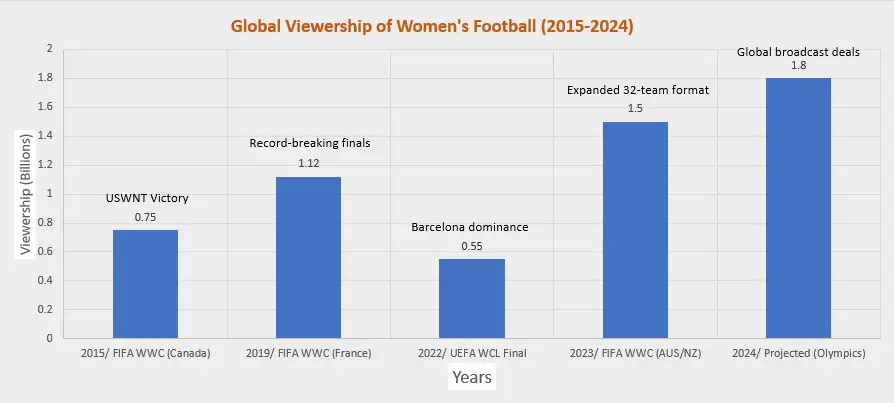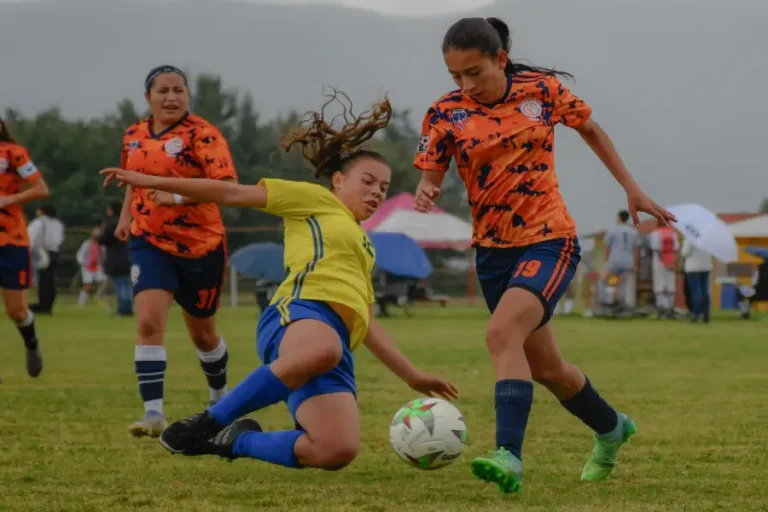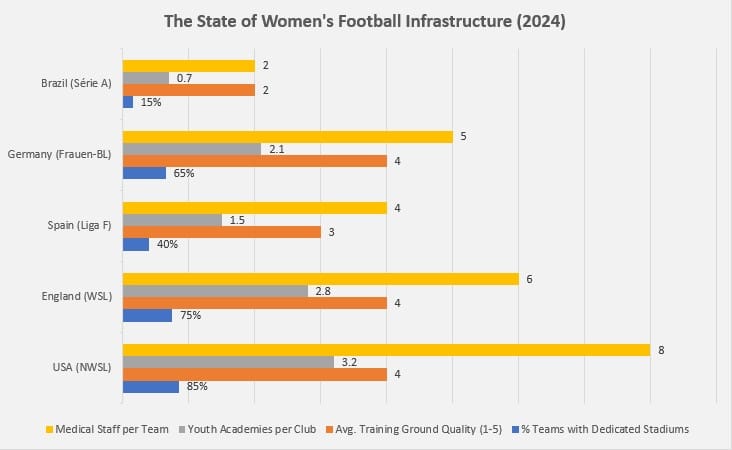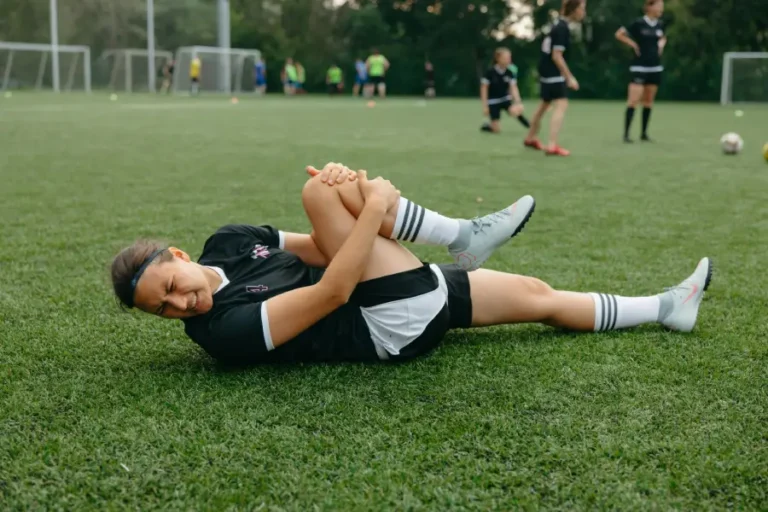- Introduction
- The Growing Popularity of Women’s Football
- 1. Increased Media Coverage
- 2. Rising Viewership and Attendance
- Key Tournaments Driving the Growth
- 1. FIFA Women’s World Cup
- 2. UEFA Women’s Champions League
- 3. National Leagues (NWSL, WSL, Liga F)
- Top Players Shaping the Game
- 1. Emerging Stars
- 2. Veteran Influencers
- Challenges in Women’s Football
- 1. Pay Gap and Investment Issues
- 2. Lack of Infrastructure
- Health and Fitness in Women’s Football
- 1. Injury Trends and Prevention
- 2. Nutrition and Training Regimens
- The Role of Technology and Analytics
- 1. Wearable Tech in Training
- 2. Data-Driven Performance Analysis
- Future of Women’s Football
- 1. Potential for Professionalization
- 2. Grassroots Development
- Conclusion
- FAQs
1. Introduction:
Women’s football has undergone a remarkable transformation in recent years, evolving from a niche sport to a global phenomenon. The increasing visibility of female athletes, combined with record-breaking tournaments and growing fan engagement, has propelled the sport into the mainstream.
This surge in popularity is not just a fleeting trend but a reflection of broader societal shifts toward gender equality in sports. Major brands, broadcasters, and sponsors are now investing heavily in women’s football, recognizing its commercial potential and cultural impact.
However, despite these advancements, challenges such as pay disparities and unequal access to resources persist. This blog delves into the latest trends, key players, health considerations, and technological innovations shaping the future of women’s football.
By examining credible data and expert insights, we aim to provide a comprehensive overview of where the sport stands today and where it’s headed. Whether you’re a die-hard fan or a casual observer, this exploration will shed light on the dynamic world of women’s football.
2. The Growing Popularity of Women’s Football
2.1. Increased Media Coverage
One of the most significant drivers of women’s football’s growth has been the dramatic increase in media coverage. Gone are the days when women’s matches were relegated to obscure time slots or ignored altogether. Today, major sports networks like ESPN, Sky Sports, and DAZN regularly broadcast women’s games, often with the same production quality as men’s matches.
According to a 2023 FIFA report, media rights for women’s football have surged by 150% since 2019. This shift is partly due to the success of high-profile tournaments like the FIFA Women’s World Cup, which has become a must-watch event for millions. Additionally, streaming platforms like YouTube and Twitch have made it easier for fans to access live games, further expanding the sport’s reach.
The rise of dedicated women’s football podcasts, documentaries, and social media coverage has also played a crucial role. For instance, the Netflix docuseries “Women’s Football Uncovered” provided an intimate look at the lives of professional players, humanizing them and attracting new fans.
2.2. Rising Viewership and Attendance
The numbers don’t lie—women’s football is drawing bigger crowds than ever before. The 2023 FIFA Women’s World Cup shattered records with 1.5 billion viewers, more than double the audience of the 2019 edition. This exponential growth underscores the sport’s expanding global appeal.
Club football is also benefiting from this boom. Barcelona Femení’s historic match at Camp Nou in 2022 drew 91,648 spectators, setting a new world record for attendance at a women’s football game. Similarly, the National Women’s Soccer League (NWSL) in the U.S. has seen average attendances rise to over 10,000 per match, a figure that continues to climb each season.
These trends are not limited to elite competitions. Grassroots women’s leagues and university matches are also experiencing higher engagement, signaling a cultural shift in how the sport is perceived.

Data Sources:
FIFA Reports: FIFA Women’s Football 2023
UEFA Analytics: Women’s Football Viewership
Nielsen Sports: Global Audience Trends

3. Key Tournaments Driving the Growth
3.1. FIFA Women’s World Cup
The FIFA Women’s World Cup has become the crown jewel of women’s football, captivating audiences worldwide. The 2023 edition, co-hosted by Australia and New Zealand, was a landmark event, featuring an expanded format with 32 teams—up from 24 in previous years. This change allowed more nations to participate, fostering global inclusivity.
Prize money also saw a significant boost, reaching 110million awarded in 2019. While this is still far below the men’s World Cup purse, the progress is undeniable. The tournament’s thrilling matches, underdog stories, and viral moments—like Morocco’s historic run to the knockout stages—cemented its status as a must-watch event.
3.2. UEFA Women’s Champions League
At the club level, the UEFA Women’s Champions League (UWCL) has emerged as a showcase for elite talent. The 2023 final between Barcelona and Wolfsburg drew 3.6 million viewers, a 56% increase from the previous year. Clubs like Lyon, Barcelona, and Chelsea have become household names, thanks to their dominance in European competitions.
The UWCL’s growing prestige has also attracted top-tier sponsors, with companies like Visa and Hublot signing multi-year deals. This financial injection is helping to professionalize the women’s game, offering players better wages and improved facilities.
3.3. National Leagues (NWSL, WSL, Liga F)
Domestic leagues are the backbone of women’s football, providing a platform for players to hone their skills and gain visibility. Here’s a closer look at three of the most influential leagues:
- NWSL (USA): The National Women’s Soccer League is the gold standard for professionalism, with average attendances surpassing 10,000and franchises like Angel City FC leveraging celebrity ownership to boost visibility.
- WSL (England): The Women’s Super League benefits from the infrastructure of Premier League clubs, with teams like Arsenal and Chelsea investing heavily in their women’s squads.
- Liga F (Spain): Home to superstars like Alexia Putellas, Spain’s top division has seen rapid growth, though disputes over pay and conditions highlight ongoing challenges.

4. Top Players Shaping the Game
4.1. Emerging Stars
The women’s game is witnessing an exciting influx of young talent that’s redefining modern football. Spanish winger Salma Paralluelo has taken the world by storm with her blistering pace and technical ability, becoming one of the most feared attackers in Europe at just 20 years old. Her transition from athletics to football has given her a unique physical edge that defenders struggle to contain.
American forward Sophia Smith represents the new generation of NWSL talent, winning the league’s MVP award at 22 with her clinical finishing and creative playmaking. These young stars aren’t just talented players – they’re social media savvy personalities who are helping grow the game’s popularity among younger audiences.
Other notable rising talents include England’s Lauren James, whose technical brilliance draws comparisons to her brother Reece James, and Colombia’s Linda Caicedo, who became a global sensation during the 2023 World Cup at just 18 years old. Their rapid development suggests women’s football’s future is in capable hands.
4.2. Veteran Influencers
While new stars emerge, established players continue to shape the game both on and off the pitch. Brazilian legend Marta, the six-time FIFA World Player of the Year, remains an inspirational figure even as her career winds down. Her advocacy for gender equality in sports has been as impactful as her on-field performances.
American striker Alex Morgan has successfully transitioned from prolific goalscorer to influential spokesperson, using her platform to fight for equal pay and better conditions. These veterans provide crucial mentorship to younger players while maintaining elite performance levels – Morgan scored the winning goal in the 2023 NWSL Championship at 34.
Their longevity demonstrates the improved sports science and career management in women’s football today. Where players once retired in their late 20s, it’s now common to see top performers competing at the highest level well into their 30s.

5. Challenges in Women’s Football
5.1. Pay Gap and Investment Issues
Despite progress, significant financial disparities remain between men’s and women’s football. The 2023 Women’s World Cup total prize money of 110 million was just 25110 million was just 25440 million awarded at the 2022 men’s tournament. This inequality trickles down to club level, where top female players earn fractions of their male counterparts’ salaries.
However, there are positive signs. The US Women’s National Team’s landmark equal pay settlement in 2022 set an important precedent. Major brands like Nike and Adidas are increasingly investing in women’s football, with signature boot deals for stars like Megan Rapinoe and Vivianne Miedema helping close the endorsement gap.
5.2. Lack of Infrastructure
Many women’s teams still lack access to adequate training facilities, medical support, and youth development systems. A 2023 UEFA study found that only 20% of top-division women’s clubs in Europe had dedicated training grounds. This forces players to share facilities with men’s teams or use inferior accommodations.
Grassroots development remains uneven globally. While nations like England and Spain have robust academy systems, many countries still struggle to provide girls with equal access to football education. FIFA’s Women’s Development Program is working to address this, but progress is slow in some regions.

Data Source: FIFA Report
6. Health and Fitness in Women’s Football
6.1. Injury Trends and Prevention
Women footballers face unique physiological challenges, with ACL injuries occurring 3-6 times more frequently than in men’s football according to BJSM research. The 2022-23 season saw high-profile ACL casualties including England’s Beth Mead and the Netherlands’ Vivianne Miedema, highlighting this persistent issue.
Leading clubs are now implementing specialized prevention programs focusing on neuromuscular training, proper warm-up protocols, and load management. Manchester City’s women’s team reported a 40% reduction in ACL injuries after introducing targeted strength and conditioning routines.
6.2. Nutrition and Training Regimens
The professionalization of women’s football has brought greater focus on sports science. Teams employ dedicated nutritionists to address female athletes’ specific needs, with emphasis on iron intake (to combat anemia risks) and tailored carbohydrate strategies for menstrual cycle management.
Training loads are carefully monitored using GPS tracking to optimize performance while minimizing injury risk. Goalkeepers now follow specialized programs to account for the biomechanical differences in women’s goalkeeping, which involves more lateral movement and less aerial play than the men’s game.


7. The Role of Technology and Analytics
Market Growth of Adaptogenic Products
7.1. Wearable Tech in Training
Modern women’s teams utilize cutting-edge technology to enhance performance. Catapult GPS vests track players’ speed, distance covered, and workload during training sessions. This data helps coaches prevent overtraining and identify when players need rest.
Goalkeepers use tools like BlazePod reaction lights to improve reflexes, while virtual reality systems help players study opponents’ tactics. These innovations, once exclusive to men’s football, are now standard at top women’s clubs.
7.2. Data-Driven Performance Analysis
Advanced analytics have transformed how women’s teams prepare for matches. Clubs use platforms like StatsBomb and Wyscout to break down every aspect of performance, from passing accuracy to defensive positioning. This data-driven approach has led to more sophisticated tactics in the women’s game.
Player recruitment has also evolved, with analytics departments using metrics to identify undervalued talent. Brighton’s women’s team famously used data analysis to build a competitive squad on a modest budget, reaching the 2023 FA Cup final.
8. Future of Women’s Football
8.1. Potential for Professionalization
The sport is moving toward full professionalization, with more leagues offering year-round contracts instead of semi-professional arrangements. UEFA’s Women’s Football Strategy aims to have all top-division clubs fully professional by 2025. This transition is crucial for player development and competition quality.
Commercial revenue is projected to grow exponentially, with Deloitte forecasting the global women’s football market will exceed $1 billion annually by 2025. As broadcast deals and sponsorship values increase, players will benefit from improved wages and working conditions.
8.2. Grassroots Development
Sustainable growth requires investment at youth level. Countries like England have implemented mandatory girls’ football programs in schools, while the US Soccer Federation’s Girls’ Development Academy is producing technically gifted players from a young age.
Emerging nations are making strides too – Zambia’s investment in youth football helped them qualify for their first World Cup in 2023. This global development will make future tournaments more competitive and unpredictable.

9. Conclusion
Women’s football stands at a crossroads between its grassroots origins and a professionalized future. The sport has made remarkable progress in visibility, quality, and commercial appeal, but challenges around equality and infrastructure persist.
The next decade will be crucial in determining whether women’s football can achieve true parity with the men’s game. With continued investment, innovation, and advocacy, the potential is limitless. What began as a marginalized sport is now inspiring millions worldwide – and this is just the beginning.
10. FAQs
Q1: Which country has the most professional women footballers?
A1: The United States leads with over 1,800 professional players, followed by Germany and England (FIFA Global Report 2023)..
Q2: How fast do women’s footballers run compared to men?
A2: Top female players reach speeds of 32-34 km/h, slightly below elite male players’ 35-37 km/h, but with comparable acceleration (Journal of Sports Sciences, 2024).
Q3: When will women’s football salaries equal men’s?
A3: Analysts project this could happen by 2035-2040 if current growth rates continue (Deloitte Sports Business Group, 2024).
Latest Articles
Popular Reviews
July 3, 2023
AmRelieve Knee support
January 15, 2025
The Role of Whey Protein for Fitness
May 31, 2023
Elastic rubber band exercise
June 6, 2023
Essential Platinum Creatine
August 6, 2023
How can we help you?
We are your one-stop-shop for all things sports, nutrition and stress management. Our team of experts provides you with the latest reviews on sports equipment, nutrition facts and stress management advice. We also provide ratings to help you make informed decisions on what to buy. Stay ahead of the game with our blog website! Join our community today and get access to exclusive content and deals.
Most used tags
#Adaptogens #ModernNutrition #HolisticHealth #StressRelief #HealthyLiving #BrainHealth #CognitiveFunction #EnduranceTraining • #ExerciseForMentalHealth #ExercisePsychology #FitnessChallenge #FunctionalFitness • #HyroxRace • #MentalFitness #MentalHealth #ExerciseBenefits #MindBodyConnection #StressRelief #FocusThroughFitness #EmotionalWellBeing #HealthyLiving #FitnessMotivation #MentalHealthAndExercise #MentalWellness #Mood-boosting winter workouts #PhysicalActivity #WellnessJourney #Winter workout motivation ACLInjury ACLSurgery Blood pressure Cardiovascular exercise ChiaPudding Exercise fitness Gains healing healthy HealthyEating HealthyRecipes HyroxFitness • injury Mental Health in Motion muscle gain NutrientPackedMeals Prevention Resistance training Sport SportsInjuryTreatment Stretching and Cooling Down Supplements therapy Top Wearable Fitness Technology Trends Shaping 2024 training weight loss wellbeing Workout Routine
If you enjoyed this blog post and want to learn more, visit our website for a wealth of tips, tricks, and resources on healthy living. Subscribe to our newsletter to stay updated with the latest insights on health, fitness, nutrition, and wellness, delivered straight to your inbox.
Don’t forget to share this blog with your friends and family. They might find these topics just as helpful and inspiring!.
Thank you for reading!










